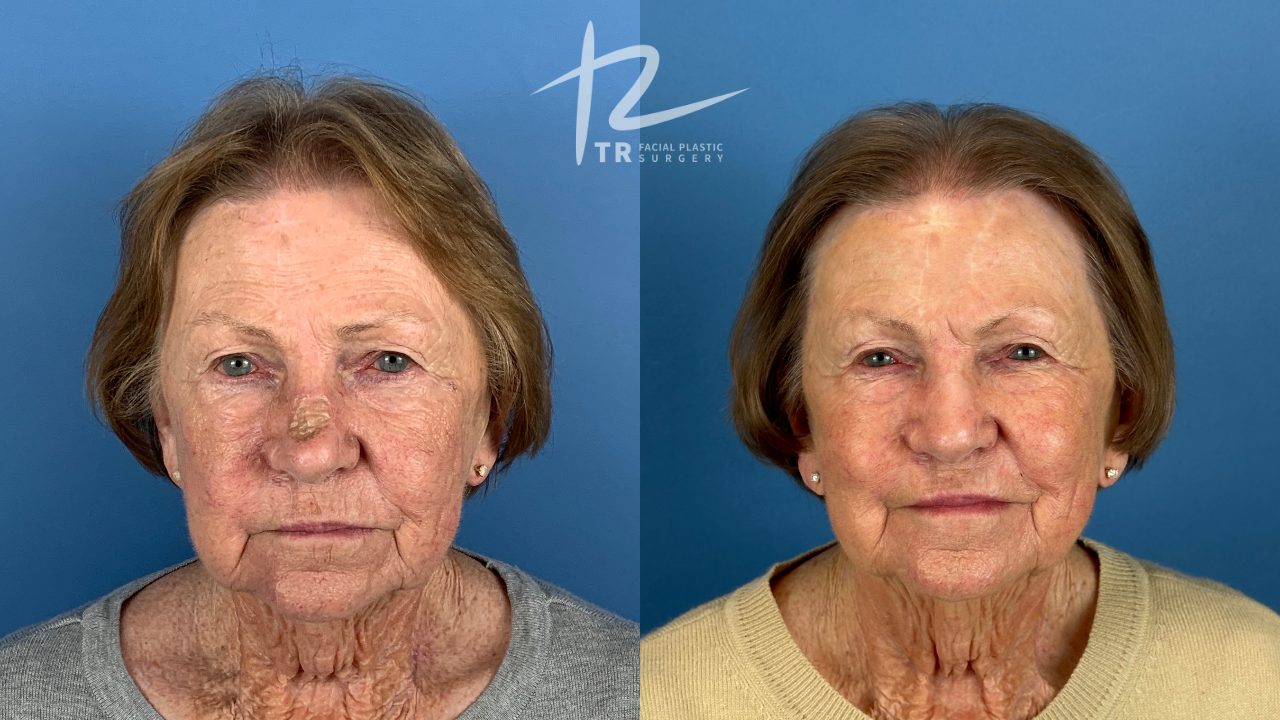Scar Revision
Candidates for a scar revision
Scar revision may be appropriate for individuals who are concerned about the appearance, texture, or location of a scar and are seeking improvement. Ideal candidates include those who:
Have scars that are raised, widened, indented, discolored, or irregular
Experience tightness, discomfort, or itching from a scar
Have fully healed from prior injury or surgery but remain dissatisfied with the outcome
Are in good general health and non-smokers
Have realistic expectations, understanding that while scars cannot be completely erased, their appearance can often be significantly refined
Before and 6 months after complete excision of nasal scar, with 2-stage reconstruction using forehead flap.
Goals of Scar Revision
The aim of surgical scar revision is to improve the appearance, texture, and overall integration of a scar so that it blends more naturally with the surrounding skin. While no scar can be completely erased, treatment can reduce its visibility, thickness, or discoloration, and in some cases, improve associated symptoms like tightness or itching.
Depending on the type and location of the scar, results may include:
A narrower, flatter, or more refined appearance
Better color and texture match with surrounding skin
Improved comfort and range of motion if the scar was restrictive
Increased confidence and satisfaction with the area’s appearance
Dr. Ramachandra tailors each treatment plan to the individual, using both surgical and non-surgical techniques to achieve results that are subtle, natural, and lasting.
The Scar Revision Procedure
Dr. Ramachandra offers a range of treatment options including surgical scar revision, dermabrasion, steroid injections, and microneedling. The best procedure for scar revision varies depending on the location and severity of the scar, the age and overall health of the patient, and the extent of revision the patient wants.
Subcision
Subcision is a procedure for treating scars that are indented. A needle is directed into the skin to break up the fibers that attach the scar to below-the-surface tissue, raising it back to the elevation of surrounding skin. It also promotes healing by creating new connective tissue that repairs and smooths the skin.
Excision
Surgical excision is most often used for severe contracture (skin-tightening) scars, and involves using a scalpel to surgically remove the scar and surrounding damaged tissue. A skin flap or graft may be used to restore the appearance of the skin in the treated area, and also improve movement and flexibility that may have been affected by the contracture.
Punch Elevation
Particularly effective for certain types of acne scars, punch elevation uses a punch tool rather than a typical scalpel to precisely remove small quantities of tissue without affecting nearby skin. The punch tool is used to lift up the base of the scar, making it appear more shallow.
Surface Treatments
Many cosmetic procedures, such as microdermabrasion, chemical peels and skin bleaching, effectively treat discolorations and mild surface irregularities by gently removing the top layers of skin and rejuvenating the underlying layers. Multiple treatments may be needed, however, to achieve noticeable results.
Laser Treatments
Similar to surface treatments, laser treatments gently remove damaged layers of skin to reveal new unblemished skin underneath, while stimulating collagen production for further gradual improvements. The precision of laser treatments ensures that only damaged tissue is treated, while healthy surrounding tissue remains intact. If laser therapy is considered the most effective option for a particular type of scar, she will ensure you are connected with a trusted specialist for this treatment. The approach is always individualized, with the goal of helping your scar blend more naturally with the surrounding skin.
Fillers
Dermal fillers are quite successful at “filling in” depressed scars and creating a smoother skin surface. Fillers are U.S. Food and Drug Administration-approved, and safe for most patients. Many fillers are made from substances found naturally in the body, or are synthetically made to mimic natural substances or stimulate collagen production. Fillers are injected directly into the skin of the targeted area to restore volume to the scar. However, results from fillers are not permanent, and followup injections are necessary to maintain the improvement they provide.
Prior to undergoing scar revision, patients are advised to stop smoking, and to avoid any medications that can cause an increase in bleeding.
Recovery from scar revision
Recovery after scar revision depends on the type of treatment performed. Most patients experience mild swelling, redness, and sensitivity for a few days to a week. Sutures (if placed) are typically removed within 5–7 days, and patients can often return to light activities within 24–48 hours. Sun protection and wound care are essential to support optimal healing and minimize pigmentation changes. Full results develop gradually over several weeks to months as the skin remodels and the scar matures.
Risks of a scar revision
As with any procedure, scar revision carries some risks, including:
Infection
Bleeding or hematoma
Delayed wound healing
Worsening or recurrence of the scar
Skin discoloration or textural changes
Asymmetry or contour irregularities
Temporary or permanent numbness
Dr. Ramachandra takes great care to minimize these risks and will provide detailed aftercare instructions to support safe and effective healing.


